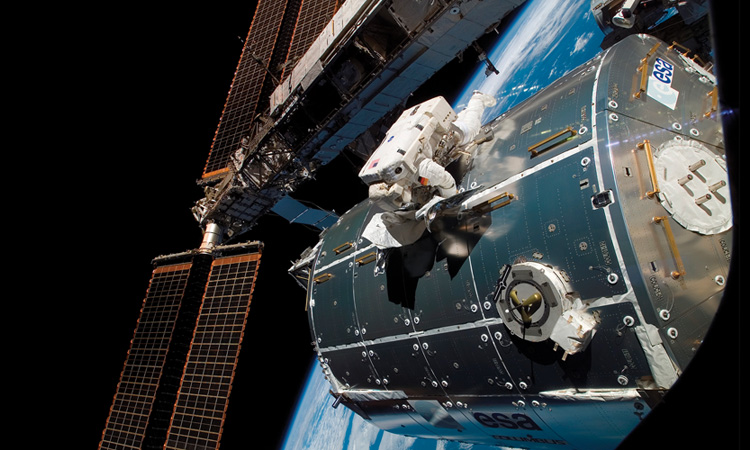 The Colombus research module on the International Space Station, which will host the COMPASSO iodine optical clock mission. [ESA / NASA]
The Colombus research module on the International Space Station, which will host the COMPASSO iodine optical clock mission. [ESA / NASA]
On 31 October 2022, a Long March rocket took off from Hainan in southern China, bound for the Tiangong space station some 400 km above Earth. It was carrying the station’s third and final module, which, among other equipment, contained a vacuum cavity, laser, optics, electronics and frequency comb. The module had successfully docked by 2 November, making this high-tech kit—designed to convert the radiation from a group of strontium atoms into exceptionally accurate “ticks”—the first-ever optical clock to enter Earth orbit.
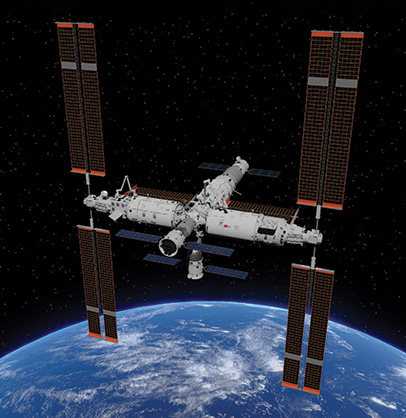 A rendering of the completed Tiangong space station, including the lab module Mengtian on the right, launched on 31 October 2022. [Shujianyang; CC-BY 4.0]
A rendering of the completed Tiangong space station, including the lab module Mengtian on the right, launched on 31 October 2022. [Shujianyang; CC-BY 4.0]
Freed from the confines of our noisy and gravitationally complex planet, optical clocks could allow scientists to test the limits of general relativity and observe new sources of gravitational waves. More practically, they might also advance satellite navigation and improve monitoring of Earth’s gravity and climate. Not least, they could help usher in a new, more precise definition of the second.
The scientists in China have so far released few details about their new clock (which sits alongside a cold-atom microwave clock and hydrogen maser), including how long it can run at any one time. But Stephan Schiller, a quantum metrologist at Heinrich Heine University, Germany, argues that its launch marks an important milestone and describes it as “the most advanced” clock in orbit. He says that Western countries, despite building ever more impressive clocks on the ground, appear to have fallen behind in transferring the technology to space.
That leap, explains Patrick Gill of the National Physical Laboratory, UK, is impeded by optical clocks’ bulk, need for power and fragility. These, he points out, are not qualities that lend themselves to spaceflight, where quarters are cramped, energy is limited and conditions are harsh—from the extreme vibrations of launch to the huge variations in orbital temperature. “The environment up there is much less forgiving than what we have on the ground,” Gill says.
Great stability
All atomic clocks mark time by keeping an electromagnetic oscillator locked to the precise frequency of a specific atomic transition. The far-higher frequencies of laser beams compared with traditional beams of microwaves yield more precise ticking rates, which shorten the time needed to achieve a certain clock stability. That, in turn, means that the numerous sources of systematic error in timekeeping—such as stray electromagnetic fields or thermal vibrations—can be identified and eliminated more quickly, boosting a clock’s accuracy.
The most accurate kinds of optical clock hold atoms tightly in place and cool them down to minimize Doppler broadening. This can be done either using lasers to maintain thousands of neutral atoms in a lattice or employing electric fields to trap a single ion (using lasers for cooling in both cases). These schemes can limit instabilities and fractional uncertainties to 1 part in 1018 or lower—some three orders of magnitude better than was possible two decades ago.
This progress opens up the prospect of a new SI second, defined in terms of optical rather than microwave cycles. First, however, different optical clocks must be compared with one another. The best way to make this comparison is to connect clocks in different labs via fiber optic cable, with the transfer stability reaching 10−19 to 10−21 (depending on length and averaging time). But such tests cannot currently be carried out using fiber under the ocean, which limits them to within rather than between continents.
Distributing frequencies to labs on opposite sides of the globe could instead be done via satellite. Clocks on the ground would be compared with one or more “master clocks” in orbit, and their ticking rates brought into line to establish a common timescale. The orbital clocks would provide an exceptionally stable reference, since they would be isolated from vibrations and other sources of surface movement, such as tides.
View from on high
In addition to timekeeping, orbital optical clocks would also naturally benefit satellite navigation. Current space networks generate extremely precise time stamps, thanks to the microwave atomic clocks housed in each satellite. That information, along with details on satellites’ orbits, allows receivers on the ground to work out the their position through a process of trilateration. By replacing microwave clocks with optical ones and also improving intersatellite communication, future networks ought to enable much more accurate positioning.
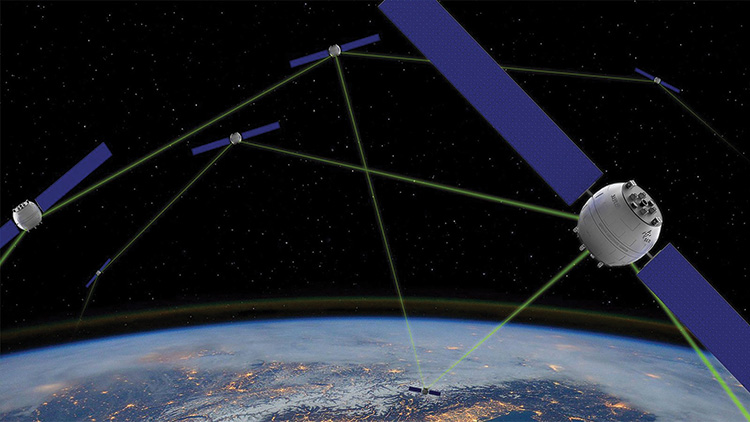 Artist’s view of the Kepler system, a proposed successor to Europe’s Galileo system that would exploit higher-stability optical clocks and free-space links. [DLR, ESA, NASA]
Artist’s view of the Kepler system, a proposed successor to Europe’s Galileo system that would exploit higher-stability optical clocks and free-space links. [DLR, ESA, NASA]
A proposed successor to Europe’s Galileo navigation system, known as Kepler, would comprise 24 satellites in medium and low Earth orbit equipped with laser-based frequency references and communicating via phase-coherent optical links. By achieving stabilities of 10−15 s/s over a wide range of sampling intervals and synchronizing timing across satellites to within a picosecond (10−12 s)—about 100 times better than is possible today—the system should enable users to determine their positions with centimeter-level accuracy.
Another area that stands to benefit from such networks is geodesy, as exceptional space-based timekeepers are able to probe geophysical phenomena in a number of ways.
Another area that stands to benefit from such networks is geodesy, as exceptional space-based timekeepers are able to probe geophysical phenomena in a number of ways. In particular, they can be used to make extremely sensitive measurements of gravitational redshift—a prediction of general relativity that tells us that clocks closer to a massive object tick more slowly and therefore have their wavelength stretched toward the red end of the spectrum.
 Illustration of a white dwarf binary star system. [T. Strohmayer (GSFC), CXC, NASA / Illustration: D. Berry (CXC)]
Illustration of a white dwarf binary star system. [T. Strohmayer (GSFC), CXC, NASA / Illustration: D. Berry (CXC)]
Clocking space-time ripples
Gravitational waves are currently detected using spatial interferometers to record miniscule relative changes in the lengths of two perpendicular arms. Optical clocks could instead monitor changes in velocity, potentially picking up radiation undetectable by either ground-based or space-based interferometers, particularly at very low frequencies.
Two masses separated by about half a wavelength of a passing gravitational wave would experience a relative back-and-forth motion as the wave propagates. This motion would very slightly modulate the Doppler shift of an electromagnetic wave sent between the two masses, which could in principle be measured by placing atomic clocks on one or both of them.
This “Doppler tracking” scheme was implemented more than 20 years ago using the Cassini spacecraft and Earth as the two masses. The frequency of a radio signal traveling to and from Cassini was compared with that of a ground-based hydrogen maser to look for any deviations from the expected Doppler shift, but sensitivity was limited by atmospheric and terrestrial noise, as well as the maser’s instability.
More recent proposals instead feature two satellites with optical clocks. Jun Ye and colleagues at JILA and Harvard University, USA, envisage free-floating test masses and an ultra-stable laser link to yield a very high yet tuneable quality factor—sensitive to the “chirp” of inspiraling black-hole pairs. Philippe Jetzer, University of Zurich, Switzerland and coworkers would instead exploit a simpler radio link, which would allow them to observe galactic white dwarf binaries.
A 10–18 variation in frequency equates to just a 1-cm change in altitude on Earth, which means that the heights of remote sites could be established very precisely by comparing the ticking of two optical clocks on the ground with a third clock in space. This capability could simplify the mapping of height variations over large distances and enable environmental monitoring via the changes in height of ice sheets or ocean surfaces.
Into the red, and beyond
Physicists have been measuring gravitational redshift for decades and can now pick out its effect over very small distances. In 2022, Jun Ye and colleagues at JILA, USA, measured the predicted frequency shift across a height difference of just 1 mm. They used an optical clock, trapping strontium-87 atoms in a vertically stratified lattice.
Gravitational redshift can also be used to test general relativity itself, with any anomaly between theory and experiment perhaps leading to a new theoretical framework that unifies the descriptions of gravity and quantum phenomena. Reaching the necessary sensitivity requires using the most precise clocks over very large distances, but progress with microwave timepieces has so far been slow.
In 1976, NASA’s Gravity Probe A experiment compared the ticking rate of two hydrogen masers—one on the ground and another in a rocket climbing to 10,000 km—and confirmed relativity’s prediction to 1 part in 104. Four decades later, measurements with the Galileo network improved on this by just one order of magnitude. The European Space Agency’s Atomic Clock Ensemble in Space (ACES)—a laser-cooled cesium clock and hydrogen maser bound for the ISS in 2025—should reach 2 × 10−6.
A flavor of optical clocks’ superiority has been given by Wenbin Shen and colleagues at Wuhan University, China, who simulated a comparison between the optical clock on Tiangong space station and a similar device on the ground. Assuming that the space clock achieves 2 × 10−15 instability after one second and reckoning on minimal atmospheric noise in the station’s precision microwave links, the researchers estimate that after 40 days of measurement, they should be able to detect an anomaly between the two clocks of about 5 parts in 107—nearly two orders of magnitude better than Galileo.
Looking to the future, Nan Yu of the Jet Propulsion Laboratory, USA, and colleagues have proposed a mission known as Fundamental physics with an Optical Clock Orbiting in Space (FOCOS). They hope to place a single state-of-the-art optical clock on a satellite in a highly elliptical orbit and record the redshift compared with that on the ground at both the satellite’s closest and farthest approaches to Earth, which they estimate would achieve a sensitivity of 10−9. But Dmitry Litvinov and Sergey Pilipenko of the Lebedev Physical Institute, Russia, reckon that putting two similar clocks on a pair of orbiting satellites, which would eliminate atmospheric noise, should push the uncertainty down to around 3 × 10−11.
Beyond redshift measurements, physicists want to use optical clocks to detect gravitational waves.
Beyond redshift measurements, physicists want to use optical clocks to detect gravitational waves (see “Clocking space-time ripples,” left). They also aim to look for any variations in nature’s fundamental constants, a feature of many extensions of the Standard Model that would change the frequencies of certain atomic transitions. A mission known as Optical Atomic Clock aboard an Earth-orbiting Space Station (OACESS), proposed by an international collaboration to precede FOCOS, would probe these variations to search for very light dark matter or dark energy. These dark particles potentially act as a collective wave manifest as oscillations in the relative output of orbital and ground-based clocks.
Not portable enough
Despite a plethora of ideas for future missions, scientists must overcome major hurdles before they can put high-performance optical clocks in space. Among these is improving links with the ground (see “New phase for time transfer,” p. 32), but especially important is ensuring that clocks have a certain size, weight and power consumption (SWaP). They also need to be adjustable remotely, with components that either have a certain guaranteed lifetime or exist as duplicates onboard.
Researchers working on ESA’s Space Optical Clock (SOC) are aware of the difficulties involved. This project had aimed at operating an optical lattice clock on the ISS by around 2023, and it got as far as transporting parts of ytterbium and strontium clocks across Europe. But limited funding has to date kept SOC Earth-bound. Schiller, a collaboration member, says that the project’s hardware “still exists but weighs a lot more and consumes a lot more power than it would do in space.”
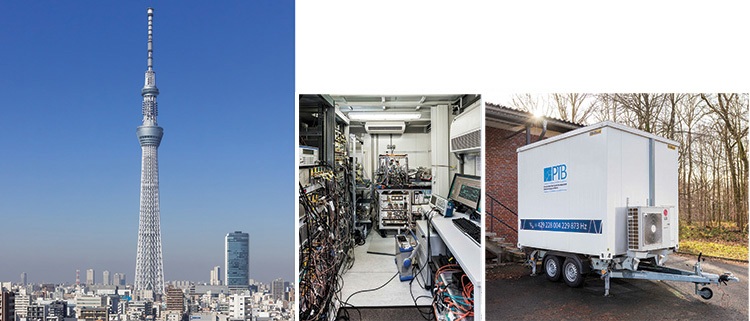 Left: Researchers in Japan have made sensitive gravitational- redshift measurements at the Tokyo Skytree tower using a pair of strontium lattice clocks. Right: A transportable strontium-87 lattice clock developed by researchers at the Physikalisch-Technische Bundesanstalt, Germany, and its trailer seen from the outside. [Kakidai / Physikalisch-Technische Bundesanstalt; CC-BY 4.0]
Left: Researchers in Japan have made sensitive gravitational- redshift measurements at the Tokyo Skytree tower using a pair of strontium lattice clocks. Right: A transportable strontium-87 lattice clock developed by researchers at the Physikalisch-Technische Bundesanstalt, Germany, and its trailer seen from the outside. [Kakidai / Physikalisch-Technische Bundesanstalt; CC-BY 4.0]
Elsewhere, scientists have continued to make progress with transportable clocks. In 2017, Christian Lisdat and colleagues at Physikalisch-Technische Bundesanstalt, Germany’s national metrology institute, put a strontium-87 lattice clock in an air-conditioned trailer and reached a systematic uncertainty of 7.4 parts in 1017 while on tour. Hidetoshi Katori of RIKEN, Japan, and colleagues have since done even better, making sensitive gravitational-redshift measurements at the Tokyo Skytree tower using a pair of strontium lattice clocks with an uncertainty of 5.5 × 10−18.
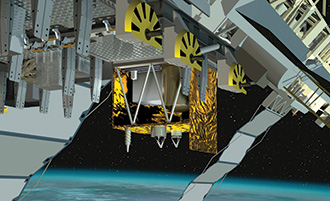 Schematic of ACES. [ESA / D. Ducros]
Schematic of ACES. [ESA / D. Ducros]
New phase for time transfer
The use of clocks in space to compare those on the ground is currently limited chiefly by atmospheric noise in the microwave signals broadcast to Earth. Scientists would instead like to use optical free-space links, as these are potentially much more stable, low power and high bandwidth. But as with the clocks themselves, here too, optical technology poses problems.
ESA’s ACES mission will improve on the existing one-way time-transfer links by using a couple of different two-way systems. One relays microwaves up and down at two slightly different frequencies, and the other bounces short laser pulses off a corner cube on the satellite. The back-and-forth signals will provide two independent sources of timing information that allow atmospheric noise to be largely filtered out.
According to mission principal investigator Christophe Salomon, the microwave system is likely to be the more stable of the two—perhaps 30 times better than current links. That’s because this signal retains its phase during the two-way trip, whereas the optical phase runs too quickly to be followed coherently in the presence of atmospheric turbulence, with the timing instead coming from pulse clicks.
As such, he says, future satellite navigation systems will probably continue to use microwave links with the ground, but they will need about 10 times the stability of ACES to keep up with the best optical clocks. Intersatellite links could instead be optical, thanks to their atmosphere-free environment, he adds, potentially building on recent advances in optical telecommunications between existing navigation satellites.
According to Gill, Katori’s group is “leading the way” in making smaller optical clocks; the team has slimmed down its devices to around 300 L. But he says that’s still far too big for space—about 10 times the volume of a typical commercial cesium clock. Trapped-ion clocks might do better, he argues, pointing out that although they stabilize more slowly than lattice clocks, they generally need fewer and less-powerful lasers, as well as smaller ovens to generate the atomic species providing the timekeeping reference (in this case a single ion).
Here too, research is afoot. Nikolay Kolachevsky of the Lebedev Physical Institute and colleagues have built a 1-m3 ytterbium-171 ion clock that has yielded long-term instabilities and uncertainties of 5 × 10−16, while Xueren Huang of the Innovation Academy for Precision Measurement Science and Technology, China, and colleagues have reported an uncertainty of just 1.1 × 10−17 using a single ion of calcium-40 transported 1200 km via truck and train. Gill and colleagues at NPL are meanwhile working on a strontium-ion clock, which he describes as “work in progress,” and are looking to integrate it with a cube-shaped optical cavity that they have patented.
Keeping it simple
Before any clock can become space-worthy, says Gill, it must pass through a series of technology readiness levels (TRLs), a concept used to benchmark a technology’s development progress on a scale of 1 to 9. After demonstrating a lab device at TRL 4, researchers need to develop an engineering model able to withstand space-like conditions, including strong vibrations, intense radiation and the swings in temperature caused by moving in and out of the sun’s glare. Following that is a test flight at TRL 7, and then full space-worthiness at TRL 8.
No optical-lattice or trapped-ion clock (from a Western country, at least) has yet passed TRL 4, according to Gill, but other devices based on simpler optical technology have progressed further. COMPASSO, developed by the German Aerospace Centre (DLR) and industry, consists of two iodine frequency references, a frequency comb and a bidirectional laser terminal. Successfully flown in a slimmed-down form on a sounding rocket in 2018, the mission should arrive at the ISS in about two years, according to DLR project member Thilo Schuldt. The SWaP of the iodine reference, he says, should be 34 L, 27 kg and 51 W, while the overall payload should weigh in at about 280 kg.
Iodine clocks are relatively straightforward devices because they don’t involve tightly confining the timekeeping particles. Instead, they keep their molecular iodine particles in a vapor cell at low pressure and about –10°C. The trick is to probe the molecular transitions using Doppler-free spectroscopy. One form of this technique involves atoms simultaneously absorbing photons from two lasers propagating in opposite directions, which cancels the unwanted shift due to atom motion.
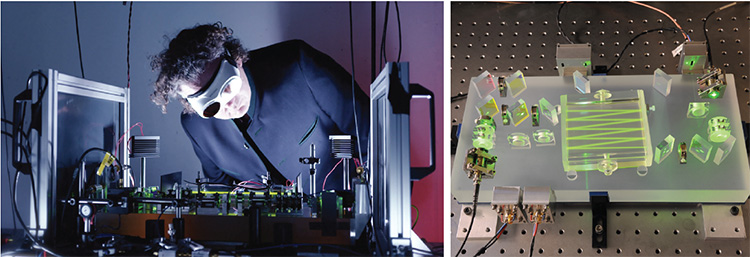 Left: Claus Braxmaier, DLR Institute of Quantum Technologies, Germany, inspecting a molecular iodine clock developed for the COMPASSO mission. Right: The spectroscopy board of an iodine frequency reference that has undergone thermal and vibration tests as part of COMPASSO. [DLR / DLR-QT: Schuldt, Braxmaier]
Left: Claus Braxmaier, DLR Institute of Quantum Technologies, Germany, inspecting a molecular iodine clock developed for the COMPASSO mission. Right: The spectroscopy board of an iodine frequency reference that has undergone thermal and vibration tests as part of COMPASSO. [DLR / DLR-QT: Schuldt, Braxmaier]
Some, including Schiller, question whether such devices should be regarded as “optical clocks,” given their pretty modest accuracies (although they have good short-term stabilities). Schuldt disagrees, insisting that the term is not dependent on performance. Moreover, he and his colleagues regard the iodine technology as a “strong candidate” for clocks in future satellite navigation systems.
Amar Vutha, University of Toronto, Canada, is also bullish about Doppler-free spectroscopy but has had to endure some disappointment. In 2019, he and colleagues flew a pair of rubidium vapor-cell clocks aboard a stratospheric balloon. Although the clocks remained locked to their respective transitions for over six hours, the researchers were unable to measure a beat note between them. They discovered that an abrupt temperature change in the tropopause had disturbed some of the optics. Vutha hopes to have another go with a slightly more demanding calcium clock, but he admits that the atmosphere “is more complicated than I had dared fear.”
Time and money
The slow progress in getting optical clocks into space has led some to scale back their ambitions. Schiller says that he and his colleagues from SOC have proposed a more stripped-down project to ESA—a €12 million (US$12.8 million) mission to compare optical clocks on different continents using a hydrogen maser or other simple “flywheel oscillator” rather than a high-performance clock. He says that the proposal was deemed feasible by a scientific panel but has yet to get the green light, describing it as a candidate mission “for the post-ISS era.”
While SOC has been scaled back, the ACES collaboration has endured long delays. The mission’s principal investigator, Christophe Salomon, Ecole Normale Supérieure, France, expects the payload to arrive at the ISS in late 2024 or early 2025—some 10 years later than expected. The problem, he says, has again been a lack of funds; ESA underestimated the cost of developing the time transfer system.
Fully operational space-based clocks, Gill says, will come about by gradually moving large laboratory clocks up the TRL scale to the point where they can survive in orbit.
Whether a full-blown optical mission gets funding elsewhere remains to be seen. A recent report by the US National Academy of Sciences on research in space recommended that space-qualified optical-lattice clocks be developed as “a top priority.” But according to Jason Williams of the Jet Propulsion Laboratory, USA, a strontium clock that he and others have been working on for possible use in OACESS currently remains a ground-based project. “That effort is not yet funded by NASA,” he says.
Schiller thinks that Western countries are destined to play catch-up to China, which he points out was the first country to put cold atoms in orbit, having launched a simplified version of ACES in 2016. That effort, he contends, required “a massive budget” as well as round-the-clock shifts. “They did everything—I mean everything—to overtake the rest of the world and be the first,” he says.
For Gill, the important thing is to make steady progress. Fully operational space-based clocks, he says, will come about by gradually moving large laboratory clocks up the TRL scale to the point where they can survive in orbit. A space-worthy clock “is not going to fall out of the sky,” he says. “You have to work at it.”
Edwin Cartlidge is a freelance science writer based in Rome, Italy.
For references and resources, visit: optica-opn.org/link/0124-optical-clocks.

